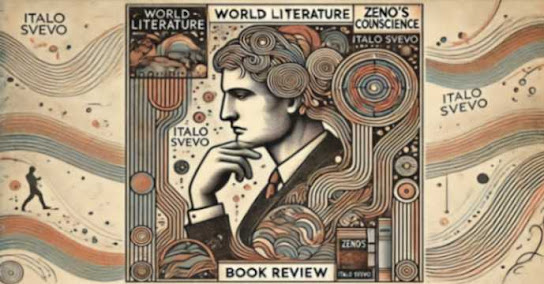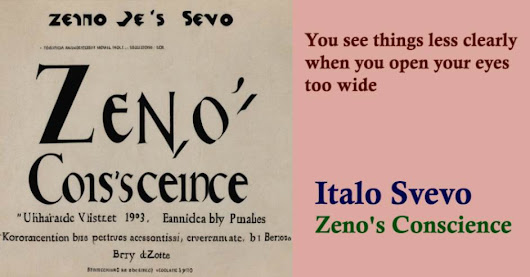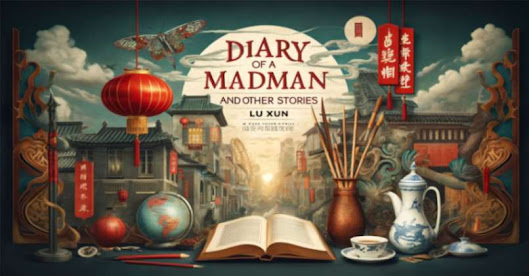 |
| Book Review – 92 – Zeno's Conscience by Italo Svevo |
Title: Zeno's
Conscience. Author: Italo Svevo. Publication Details: Originally
published in 1923, first English translation in 1930 by Beryl de Zoete. Genre:
Modernist Novel, Psychological Fiction.
Introduction
Italo
Svevo’s Zeno’s Conscience holds an esteemed place in early 20th-century
European literature as a seminal exploration of the human psyche. This
groundbreaking psychological novel captures the nuanced complexities of human
behavior, the pervasive influence of self-deception and the intricate workings
of memory and consciousness. Framed as a fictional autobiography, the narrative
introduces us to Zeno Cosini, an aging man who embarks on a journey of
introspection, recounting his vices, relationships and existential musings.
Svevo’s innovative narrative style and deep psychological insight were ahead of
their time and gained broader recognition through the endorsement of James
Joyce, who admired Svevo’s ability to weave profound philosophical themes into
a deeply personal story. This review seeks to provide an extensive examination
of the novel’s plot, thematic concerns, stylistic elements and critical
reception.
| Quote from Zeno's Conscience by Italo Svevo |
Summary of the Plot
The
narrative of Zeno’s Conscience unfolds through a series of memoirs penned by
Zeno Cosini, a businessman in the city of Trieste, as part of his
psychoanalytic therapy. These confessions are presented thematically, offering
readers a fragmented yet richly detailed account of Zeno’s life. From the
outset, Zeno’s attempts to quit smoking set the tone for his ongoing battle
with self-control and self-delusion. He repeatedly declares his intention to
abandon the habit, yet he paradoxically cherishes it as a symbol of his
individuality and defiance.
Zeno’s
relationships are central to his narrative. His courtship of the Malfenti
sisters forms a pivotal episode, highlighting his indecision and flawed
judgment. While initially infatuated with Ada, Zeno eventually marries Augusta,
whom he regards as less attractive but later appreciates for her unwavering
kindness and emotional stability. Despite his professed respect for Augusta,
Zeno’s extramarital affair with Carla, a young singer, showcases his moral
ambivalence and further complicates his self-perception.
The
memoirs also delve into Zeno’s professional life, marked by his reluctance to
fully embrace his role in his father-in-law’s business. His rivalry with Guido
Speier, a confident and ambitious businessman, exacerbates Zeno’s feelings of
inadequacy. Guido’s eventual downfall and untimely death become a source of
both guilt and relief for Zeno, underscoring his ambivalent nature.
The
novel concludes on a philosophical note, as Zeno reflects on the human
condition and contemplates the possibility of universal destruction. These
closing thoughts leave readers grappling with profound questions about life,
death and the nature of existence.
Analysis
of Themes
Self-Deception: At the heart of
Zeno’s Conscience lies the theme of self-deception, intricately woven into
every facet of the protagonist’s life. Zeno’s struggles with smoking serve as a
vivid metaphor for his broader inability to take responsibility for his
actions. He constructs elaborate justifications for his failures, framing his
inability to quit smoking as an external battle rather than a reflection of his
lack of willpower. This tendency to rationalize his shortcomings is evident in
his relationships and business dealings, where he frequently shifts blame onto
others or circumstances. Svevo’s exploration of self-deception illuminates a
universal human trait: the reluctance to confront uncomfortable truths about
oneself.
The
Unreliability of Memory: Memory in Zeno’s Conscience is portrayed as
inherently flawed and subjective. Zeno’s recollections are often contradictory,
exposing the malleable nature of memory and its role in shaping identity. His
memoirs are less about presenting an objective account of events and more about
constructing a narrative that aligns with his current self-image. By
emphasizing the inconsistencies in Zeno’s accounts, Svevo challenges readers to
consider the ways in which individuals reinterpret their past to make sense of
their present.
Existentialism
and Modernity:
Svevo’s novel grapples with existential questions that resonate with the
modernist era’s philosophical concerns. Zeno’s reflections on the meaning of
life, the inevitability of death and the disorienting effects of a rapidly
modernizing world reflect a deep engagement with existentialist themes. His
musings often verge on nihilism, as he contemplates the futility of human
endeavors and the fragility of existence. These existential explorations imbue
the novel with a timeless quality, inviting readers to ponder their own place
in an ever-changing world.
Interpersonal
Relationships:
The dynamics of Zeno’s relationships provide a lens through which to examine
his emotional and psychological complexities. His strained relationship with
his domineering father sets the stage for his lifelong insecurities and need
for validation. In his marriage to Augusta, Zeno finds stability, yet he
undermines this through infidelity, revealing his inability to reconcile his
desires with his sense of duty. His interactions with friends, particularly
Guido, further underscore his emotional shortcomings and ambivalence. Through
these relationships, Svevo captures the intricacies of human connections,
marked by both intimacy and alienation.
Style
and Structure
Narrative
Style
Svevo’s
use of a fragmented, non-linear structure mirrors the chaotic and associative
nature of human thought. Rather than following a chronological progression, the
novel is organized thematically, with each chapter focusing on a distinct
aspect of Zeno’s life. This episodic format allows readers to gradually piece
together Zeno’s character and motivations, creating a mosaic of his psyche. The
inclusion of an unreliable narrator adds another layer of complexity,
compelling readers to question the veracity of Zeno’s accounts and engage more
actively with the text. This innovative narrative style was groundbreaking for
its time and has influenced countless modernist works.
Language
and Tone
The
language in Zeno’s Conscience is distinguished by its irony and wit, which
Svevo employs to great effect. Zeno’s self-deprecating humor softens the
introspective and at times, bleak tone of the novel, making his struggles both
relatable and endearing. Svevo’s prose seamlessly transitions between
lighthearted anecdotes and profound philosophical reflections, capturing the
multifaceted nature of the protagonist’s inner world. This duality— humor and
pathos— imbues the novel with a rich emotional texture, ensuring that readers
remain deeply engaged with Zeno’s journey.
Critical
Evaluation
Strengths
Psychological
Depth:
Svevo’s portrayal of Zeno’s psyche is a masterclass in psychological realism.
The intricate exploration of Zeno’s thoughts, emotions and motivations offers
readers a profound understanding of human behavior. Svevo’s ability to capture
the inner conflicts and contradictions of his protagonist resonates deeply with
readers, making Zeno’s journey a universal reflection of the human condition.
Innovative
Narrative:
The novel’s fragmented, non-linear structure and the use of an unreliable
narrator were groundbreaking for its time. Svevo’s approach to storytelling
mimics the erratic and associative nature of human memory and thought,
influencing subsequent works in modernist literature and setting a precedent
for psychological fiction.
Universal
Themes:
The exploration of themes such as self-deception, existentialism and the
complexity of human relationships ensures the novel’s relevance across
generations. Svevo’s insights into the human condition are timeless, offering
readers a lens through which to examine their own lives and struggles.
Weaknesses:
Pacing
Issues:
The episodic structure, while innovative, can feel disjointed and slow for some
readers. The introspective passages, rich in detail and philosophical musings,
may appear repetitive, potentially alienating those who prefer a more linear or
action-driven narrative.
Lack
of Resolution:
The open-ended conclusion, coupled with Zeno’s persistent ambiguity, may
frustrate readers seeking closure. Svevo’s reluctance to provide definitive
answers reflects the novel’s existential themes but can leave some readers
feeling unsatisfied.
Conclusion
Zeno’s
Conscience stands as a towering achievement in modernist literature, offering
an unparalleled exploration of the human mind. Italo Svevo’s innovative
narrative techniques, combined with his profound examination of universal
themes, have solidified the novel’s place in the literary canon. While its
introspective nature and unconventional structure may pose challenges, these
very qualities contribute to its enduring appeal and significance. For readers
intrigued by the intersections of psychology, philosophy and literature, Zeno’s
Conscience offers an immersive and unforgettable journey into the depths of
human consciousness.
References
1. Svevo,
Italo. Zeno's Conscience. Translated by Beryl de Zoete, Vintage International,
2003.
2. Joyce,
James. "Italo Svevo and the Modernist Novel." Modernist Writers and
Their Legacy, 1925.
3. Montale,
Eugenio. "On the Genius of Italo Svevo." Italian Literary Review,
vol. 12, no. 4, 1934, pp. 45-60.
4. Stoll,
Elmer. Consciousness in Literature: Studies in Modernist Fiction, Oxford
University Press, 1958.
The first Nobel Laureate in Literature from Italy was Giosuè Carducci, who won the prize in 1906. Read more about him following link:
https://worldliterature24.blogspot.com/2024/03/novel-laureate-1906-giosue-carducci.html
Frequently
Asked Questions (FAQs)
What
is the main theme of Italo Svevo’s Zeno’s Conscience?
The
novel’s primary theme is self-deception, as Zeno grapples with his vices,
relationships and existential musings while avoiding uncomfortable truths about
himself.
How
does Svevo’s work reflect modernist literature?
The novel’s fragmented structure, psychological depth and exploration of existential themes align with the principles of modernist literature.











